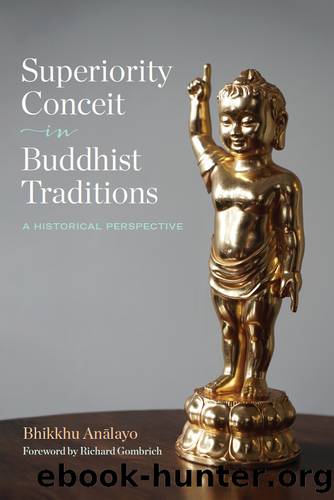Superiority Conceit in Buddhist Traditions by Bhikkhu Analayo

Author:Bhikkhu Analayo
Language: eng
Format: epub
Publisher: Wisdom Publications
5. AUTHENTICATING THE ABHIDHARMA
The Buddhaâs assumed omniscience appears to have been one of the chief strands that influenced the emergence of Abhidharma thought. This significant development does not appear to be merely the product of formal elements, such as summaries (mÄá¹ikÄ) or question and answer exchanges (AnÄlayo 2014b: 21â28). Instead, a central driving force seems to have been the attempt to provide a comprehensive map of the teachings, similar in thrust to the notion of omniscience that had eventually been attributed to the Buddha.
Comparable to the beginnings of the bodhisattva ideal, initial stages of Abhidharma thought can be discerned through comparative study of the early discourses (AnÄlayo 2014b). Besides being invested with an increasing aura of supremacy, the gradually emerging corpus of Abhidharma teachings also needed to be authenticated as stemming from the historical Buddha himself. For this purpose, members of the TheravÄda traditions employed the same strategies, be this intentionally or in the sincere belief that such teachings indeed stemmed from the Buddha, that they have tended to criticize in the case of their MahÄyÄna brethren.
The way TheravÄdins solve the problem of authenticating the Abhidharma can be seen in the Visuddhimaggaâs account of a sojourn of the Buddha in the Heaven of the Thirty-Three, during which he purportedly taught the Abhidharma to the denizens of heaven (translated by ÃÄá¹amoli 1991: 387). Buddhaghosa relates that the Buddha would daily repeat, in the presence of his human disciple SÄriputta, what he had just taught to the denizens of heaven. In this way, the transmission of the Abhidharma was ensured.
The Visuddhimagga also reports that the ruler of the Heaven of the Thirty-Three built a flight of stairs for the Buddhaâs descent back to earth, after the completion of his sojourn of three months in heaven (translated by ÃÄá¹amoli 1991: 388). Given his earlier easy commutation to heaven by supernormal powers, it is unexpected that his descent would require stairs. Closer inspection of relevant material gives the impression that this idea would have resulted from a process of cross-fertilization between text and art (AnÄlayo 2015d: 424â29), similar to the development of some of the Buddhaâs physical marks, discussed in the previous chapter (see p. 45). During an early period of âaniconicâ depiction of the Buddha, a ladder or a flight of stairs would have been an obvious way to symbolize that he is descending. Such symbolic presentation appears to have been taken literally by later generations, leading to the idea that there must have been an actual flight of stairs by which the Buddha descended from heaven. Figure 8 shows the employment of a kind of ladder on which the Buddha descends to earth, after the completion of his three-month period of teaching Abhidharma in heaven.
Download
This site does not store any files on its server. We only index and link to content provided by other sites. Please contact the content providers to delete copyright contents if any and email us, we'll remove relevant links or contents immediately.
The Way of Zen by Alan W. Watts(6292)
Ego Is the Enemy by Ryan Holiday(4963)
The Art of Happiness by The Dalai Lama(3851)
The Book of Joy by Dalai Lama(3704)
Why Buddhism is True by Robert Wright(3290)
Spark Joy by Marie Kondo(3089)
Shift into Freedom by Loch Kelly(3031)
Happiness by Matthieu Ricard(2888)
A Monk's Guide to a Clean House and Mind by Shoukei Matsumoto(2786)
The Lost Art of Good Conversation by Sakyong Mipham(2443)
The Meaning of the Library by unknow(2390)
The Third Eye by T. Lobsang Rampa(2174)
The Unfettered Mind: Writings from a Zen Master to a Master Swordsman by Takuan Soho(2160)
Red Shambhala by Andrei Znamenski(2073)
Anthology by T J(2047)
The Diamond Cutter by Geshe Michael Roach(1957)
Thoughts Without A Thinker: Psychotherapy from a Buddhist Perspective by Epstein Mark(1899)
Advice Not Given by Mark Epstein(1766)
Twilight of Idols and Anti-Christ by Friedrich Nietzsche(1764)
